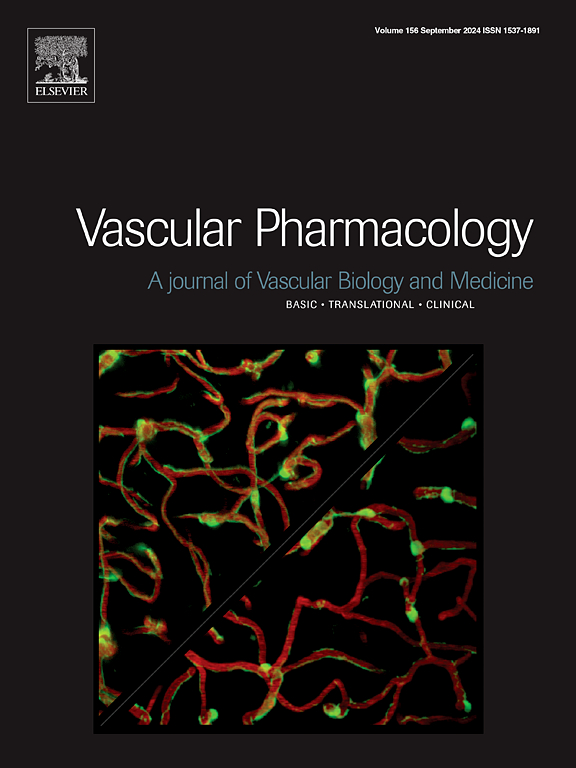抗血小板治疗指征患者的吲哚布芬与阿司匹林:系统回顾和荟萃分析。
IF 3.5
3区 医学
Q2 PHARMACOLOGY & PHARMACY
引用次数: 0
摘要
简介:阿司匹林通常被推荐给经历过中风或心肌梗死(MI)的个体。吲哚布芬,一种环氧化酶-1抑制剂,已被研究作为潜在的替代品。我们进行了一项荟萃分析和试验序贯分析(TSA)来比较吲哚布芬和阿司匹林在需要抗血小板治疗的患者中的疗效。方法:我们检索PubMed、Scopus和Cochrane Central以比较吲哚布芬和阿司匹林抗血小板治疗的研究。我们关注疗效结局,如复合血管事件、心肌梗死和缺血性卒中,以及安全性结局,如大出血和任何出血。采用I2统计评估异质性,我们的分析遵循PRISMA指南。结果:本综述纳入5项研究,共11943例患者(吲哚布芬患者 = 5952 49.84 %),3项研究涉及心肌梗死后患者,2项研究涉及脑卒中后患者。90 天时,两组间复合血管事件无显著差异(RR 0.84;95 % ci 0.46-1.53;p = 0.560;I2 = 53 %)和1年(RR 1.13;95 % ci 0.99-1.29;p = 0.08;I2 = 0 %)。Mi (rr 0.73;95 % ci 0.43-1.22;p = 0.22;I2 = 0 %),缺血性卒中(RR 1.16;95 % ci 0.99-1.37;p = 0.06;I2 = 0 %)和心血管死亡(RR 1.35;95 % ci 0.80-2.26;p = 0.257;I2 = 0 %)在1年后也无显著差异。1 年大出血(RR 0.73;95 % ci 0.41-1.31;p = 0.297;I2 = 64 %)具有可比性,但1 年的任何出血均具有显著性差异(RR 0.65;95 % ci 0.43-0.98;p = 0.03;I2 = 87 %)倾向于吲哚布芬。随机对照试验的亚组分析显示,吲哚布芬治疗缺血性卒中的风险略有增加(RR 1.18;95 % ci 1.00-1.39; = 0.05页)。结论:吲哚布芬联合抗血小板治疗的疗效和安全性与单用阿司匹林相当。因此,对于对阿司匹林不耐受或过敏的患者,吲哚布芬可以被认为是一种合适的替代药物。然而,需要更多的涉及更大人群的试验来确定其临床适用性。本文章由计算机程序翻译,如有差异,请以英文原文为准。

Indobufen versus aspirin in patients with indication for antiplatelet therapy: A systematic review and meta-analysis
Introduction
Aspirin is commonly recommended for individuals who have experienced stroke or myocardial infarction (MI). Indobufen, a cyclooxygenase-1 inhibitor, has been studied as a potential alternative. We conducted a meta-analysis and trial sequential analysis (TSA) to compare indobufen with aspirin in patients requiring antiplatelet therapy.
Methods
We searched PubMed, Scopus, and Cochrane Central for studies that compared indobufen and aspirin antiplatelet therapies. We focused on efficacy outcomes, such as composite vascular events, MI, and ischemic stroke, and safety outcomes, such as major bleeding and any bleeding. Heterogeneity was assessed using I2 statistics, and our analysis followed the PRISMA guidelines.
Results
The review included 5 studies with 11,943 patients (indobufen n = 5952, 49.84 %), three involving post-MI and two involving post-stroke patients. No significant differences were found between the groups in composite vascular events at 90 days (RR 0.84; 95 % CI 0.46–1.53; p = 0.560; I2 = 53 %) and 1-year (RR 1.13; 95 % CI 0.99–1.29; p = 0.08; I2 = 0 %). MI (RR 0.73; 95 % CI 0.43–1.22; p = 0.22; I2 = 0 %), ischemic stroke (RR 1.16; 95 % CI 0.99–1.37; p = 0.06; I2 = 0 %), and cardiovascular death (RR 1.35; 95 % CI 0.80–2.26; p = 0.257; I2 = 0 %) at 1-year also showed no significant differences. Major bleeding at 1 year (RR 0.73; 95 % CI 0.41–1.31; p = 0.297; I2 = 64 %) was comparable, but any bleeding at 1 year showed a significant difference (RR 0.65; 95 % CI 0.43–0.98; p = 0.03; I2 = 87 %) favoring indobufen. Subgroup analysis of RCTs showed marginally significant increased risk regarding ischemic stroke with indobufen (RR 1.18; 95 % CI 1.00–1.39; p = 0.05).
Conclusion
The efficacy and safety of antiplatelet therapy with indobufen were comparable to those of aspirin alone. Therefore, indobufen can be considered as a suitable alternative for patients who are intolerant or hypersensitive to aspirin. Nevertheless, additional trials involving larger populations are required to establish their clinical applicability.
求助全文
通过发布文献求助,成功后即可免费获取论文全文。
去求助
来源期刊

Vascular pharmacology
医学-药学
CiteScore
6.60
自引率
2.50%
发文量
153
审稿时长
31 days
期刊介绍:
Vascular Pharmacology publishes papers, which contains results of all aspects of biology and pharmacology of the vascular system.
Papers are encouraged in basic, translational and clinical aspects of Vascular Biology and Pharmacology, utilizing approaches ranging from molecular biology to integrative physiology. All papers are in English.
The Journal publishes review articles which include vascular aspects of thrombosis, inflammation, cell signalling, atherosclerosis, and lipid metabolism.
 求助内容:
求助内容: 应助结果提醒方式:
应助结果提醒方式:


